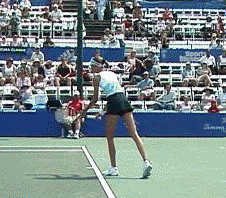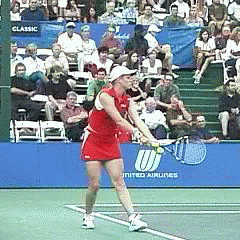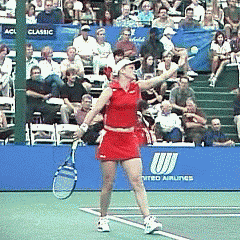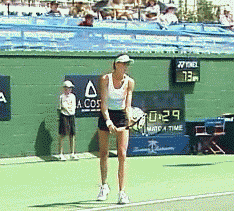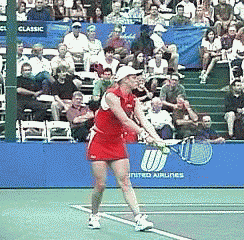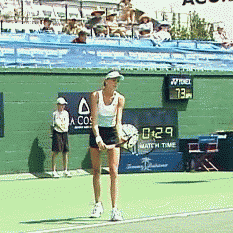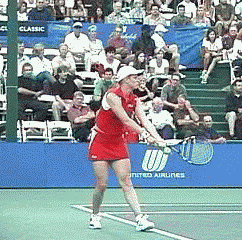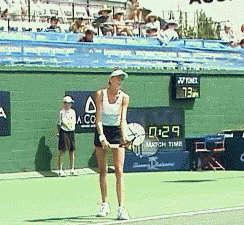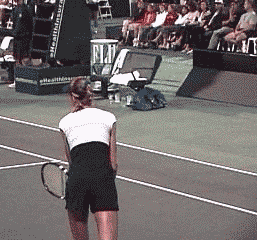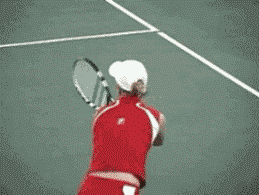|
TennisOne Lessons
By Doug King The serve is arguably the most important shot in tennis. It is the first shot played in a point and often determines the complexion and outcome of the point. An effective serve can gain free points or set up offensive opportunities putting tremendous pressure on an opponent. On the pro level a weak serve is a huge liability, especially against today's punishing returns. Since the serve by definition is a short ball, if it lacks pace, movement, and/or placement, players will jump all over it, taking away the initiative and dictating the outcome of the point or hitting outright winners. The serve is, for many, the most complicated stroke in tennis. Even though you don't have to deal with reacting and positioning yourself to your opponent's shot, there are still serious challenges presented by the serve. The difficulties fall into two logical categories.
The reason we contact the ball so high above the head on the serve is not because we have more power and control there (Actually, that makes it more difficult), but because it creates a more advantageous angle into the service box. Imagine the difficulty of swinging a long broom at the ball and this will illustrate the problems of an extended arm swing. Hingis, Kournikova - even Caprioti and Venus Williams have had great difficulty from time to time with the complexities of the serve.
We will study the serve by comparing the serves of two of the top players on the women's pro tour, Daniela Hantuchova and Kim Clijsters. They present an interesting comparison since they are very different body types, Clijsters, compact and powerful, capable of explosive bursts, and Hantuchova lanky and slender, with great reach and leverage. Although different in their physique we will notice similarities in the basic components of their serves and examine subtle differences that separate these two players. Stage 1: The Toss The key to the toss is to separate the ball tossing action from the hitting action. We are often told to lift the hands/arms together. I feel this is the most difficult way to achieve a smooth tossing motion and a poor way to load up power for the hit. The toss is a relaxed fluid motion that should have very few interfering actions. Try tossing a ball up without a racquet in your hand with your right hand set on the right hip (right handed players).
Notice how simple it is to repeat the toss with balance and accuracy. However, once you put the racquet preparation into the mix, the motion becomes infinitely more complex. This is because unconscious things going on in the right hand and arm greatly effect what happens on the left side. Both Clijsters and Hantuchova complete the tossing motion with very little lift of the racquet or movement in the feet. One of the few players I can think of who raises both arms together is Patrick Rafter and, although he has a great serve, he is also afflicted with errant tosses ("Sorry, Mate" - gotta love him) and a bad shoulder (Ouch!). Clijsters and Hantuchova both achieve a smooth lift of the tossing arm starting with a smooth weight shift from front to back. Through out the toss their bodies are very free of excessive movements (bends, dips, twists, right arm swings, racquet flips, etc.,). There is virtually nothing that will throw off the accuracy and timing of the ball toss.
Hantuchova starts with her arms almost completely extended down with her hands very close to her thighs. Consequently there is very little swing of the arms, just lift. At release her body is perfectly balanced and her weight is solidly centered between both feet (which at this point are quite well set on the ground). Clijsters starts her serve with her arms extended more in front of her body. This creates slightly more momentum and arm swing resulting in more extension of the right arm to the back through the toss. The trick is to keep the right shoulder relaxed so that the left shoulder can properly lift through to the proper follow through position. That position should be the left shoulder raised up into the left cheek. We see that clearly with both Clijsters and Hantuchova.
Notice how the left arm has remained straight throughout the toss and has continued lifting until the left shoulder has touched into the side of the face. The release of the ball has occurred somewhere in that motion and in this way it is very much like a separate stroke that has backswing, release, and follow through. I call this the "toss stroke". This stroke (as all strokes) is most effectively executed by focusing on the controlled movements of the core muscle groups and keeping the fine muscle groups more relaxed. Think of letting the tossing arm hang and let the left shoulder smoothly lift to the side of the face. Excessive efforts to control the placement of the ball toss usually result in tense, jerky movements. The racquet arm has extended back but the grip has remained relaxed and the wrist passive as is evidenced by the position of the racquet head (down) in the hand. Do not think hit yet. Any grabbing of the racquet will cause a sympathetic "grabbing" in the left hand and cause a jerky toss. Let the racquet arm float back into position as though the arm is filled with helium.
Stage 2: The Gathering Storm As the body starts to gather for the hit at the end of the toss we can see slight differences in the body and racquet positions. Clijsters keeps her right elbow relatively high and maintains a slight forward orientation of her body into the court. Her shoulders remain quite level and there is little flex (dip) in the right side of her body during the backswing. Her back foot does not slide forward much and this also tends to keep her fairly level and forward. Hantuchova on the other hand pulls her back foot forward more and adds more flex to the right side of her body. She also has a more upward orientation of her body and less forward than Clijsters. The racquet position and flow of movement of the racquet is quite different at this stage also. Clijsters has a very continuous flow of the racquet head down the back as she draws her back foot up. There is no pause and the racquet gets down the back rhythmically.
Hantuchova's racquet has a delay with the racquet held out away from the body as the back foot draws forward. This, in my opinion, is a breakdown area that causes a loss of rhythm and power for Hantuchova. It's where her racquet and body start to get out of sync. Hantuchova pulls the back foot forward quite early and quite far. This creates an excessive bend to the body and a slightly "stuck" position. So we see a fluid, compact drawing back of the racquet from Clijsters and a more exaggerated forward pull of the lower body and extension of the arm from Hantuchova. There is also a slight pause here (hitch) that causes a jerky, rushed movement to reinitiate momentum. The result is a rushed drive up into the ball with the body and an overextended arm swing that will force her to exert too much effort. As the body starts moving up to the hit the arm has to rush to catch up to the body but never quite does. It results in an over swinging of the arm that we will discuss further on.
Stage 3: Up and Away Simultaneous to the fall of the racquet down the back is the driving up and forward motion of the legs. This upward/forward energy generated by the leg thrust gets transferred through the right side of the body and into the arm beginning with a lift and turn of the shoulder and then elbow. The transfer of energy from one body section to the next is based upon passive delays in the receiving body section and movements and stops in the sending body section. It is the stop of the movement that sends the energy into the next section provided that section is relaxed to receive it. That is why any premature tightening (rushing) in the upper body and arm will result in a loss of power as will too much swinging, since it is the stop of the movement that is delivering the transfer and increasing acceleration.
Think of the trunk of the body as the handle of a whip and the shoulder and arm as the attached whipcord. Control the timing and the direction of the movement of the handle and let the cord follow passively. As the racquet head drops down the back it naturally loses momentum for a moment at the low point in the drop as it changes direction. Most people are in a hurry to get speed in the racquet head at this point, or in Hantuchova's case, she is a little out of time with the arm and the body. Hantuchova's drive up into the ball lacks the forward momentum that Clijsters shows. Hantuchova's ball toss is a little further back than Clijsters'. You can see she has pulled her hips in front of the contact point so she has little forward drive from the lower body into the court. Hantuchova's arm has to rush through this part of the backswing which does not let the wrist stay as relaxed and the arm as compact as it approaches the ball.
Clijsters does a nice job of keeping the arm in correct position and timing with the body. She brings the right hand into position close to the back of the head early enough so that the hand can set into that position and await the change of momentum of the body with a relaxed a arm. She does not rush the racquet down and up out of the back scratching position. This delay and relaxation of the hand down the back will result in a more compact and powerful wrist position coming into contact. Stage 4: The Moment of Truth It is through the hit that I have the most problem with both players. Although as I have mentioned, Clijsters has a better overall rhythmic and compact serve (by the way, Hantuchova's size and frame has nothing to do with keeping the swing compact. Sampras is lanky and fluid and has the most compact serve that I have seen) I feel they both fail on delivering a proper snap on the ball.
Both players drive through the ball - straightening their arms out through the contact - but both suffer a bit from over swinging (Hantuchova more than Clijsters). In a proper snap the upper arm (elbow to shoulder) will throw upward and rotate (pronation) driving the shoulder up into the right ear. The upper arm will stop its forward motion just behind the ear and transfer into a forward rotation of the lower arm. The stopping of the upper arm is critical to the proper acceleration of the lower arm. It also allows the arm to stay up insuring that the racquet drives up through the ball. You can see this with the big servers by their customary "hooked arm" follow throughs (Sampras, Becker, Roddick, Dent, Rusedski, and Serena). The right shoulder is held in position close to the ear as the snap comes from hand with the legs providing upward and forward thrust.
By keeping the shoulder up, the whole body gets better connected into the contact. The correct motion, as described previously, will produce a relaxed wrist snap commonly referred to as a "live arm". Simply swinging hard (overswinging) will pull the arm down prematurely causing off center hits and injury. The hand should come into play for only a brief moment on the contact and then it should become passive almost immediately after. Letting the arm simply swing fast through the final stage of the hit does not make as efficient use of the whip energy and causes a slight loss of power and balance coming out of the serve. The faster the hand comes back into the body the more that the energy is being pulled out of the contact. I think this is a flaw in many of the women players (Serena excepted - she is fabulous). You can see Clijsters' right shoulder seems to be suspended in the air longer than Hantuchova's, whose arm drops and wraps around her left side too much. Summation Clijsters and Hantuchova both have beautiful serves that any one of us would love to possess. As we can see timing, rhythm, and form are critical elements in developing a consistent, powerful serve. Although Clijsters is smaller with less potential for reach and leverage, it is through better timing and mechanics that she is able to deliver a more reliable and offensive serve. The relaxed fluid development of acceleration, the ability to accurately direct the energy, and the ability to properly hold the body in position to contribute to the racquet at contact, are much more important than effort. |

